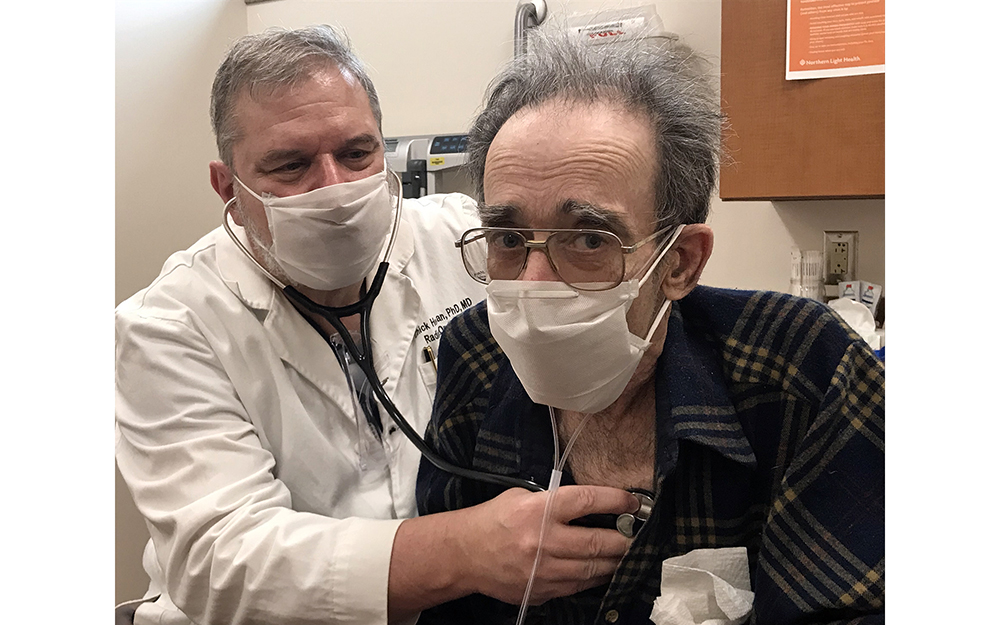
PRESQUE ISLE, Maine — Northern Light AR Gould Hospital is proud to announce a new treatment option available for certain cancer patients. Stereotactic body radiation therapy is an advanced, high-tech treatment option to add to the hospital’s arsenal against cancer.
AR Gould Hospital already provides the most comprehensive cancer care north of Bangor, and those services expanded when the hospital provided an SBRT treatment to its first patient last month on March 4. Receiving that treatment was Jerry Boulier of Fort Fairfield.
“It was great to have this treatment closer to home,” said Boulier, who underwent the same type of therapy in Bangor two years ago. “When I traveled to Bangor, I stayed with my son who took me to appointments. While it was great seeing him, I prefer being able to be home, especially during the winter months. I can deal with it better when I am able to go home after a treatment.”
SBRT is a cancer treatment that delivers extremely precise, very intense doses of radiation to cancer cells while minimizing damage to healthy tissue. This happens by focusing multiple weak beams from different directions into an intense, cancer-killing dose, much like a magnifying glass focuses the rays of the sun. This treatment has shown dramatically better outcomes and fewer side effects than conventional radiation therapy.
“Conventional radiation therapy has involved small doses over long courses of treatment. With SBRT, we now have the ability for pin point accuracy and can provide a greater effective dose of radiation with fewer treatments and less damage to surrounding tissue,” explained Charles Hechtman, PhD, MD, radiation oncologist at Northern Light AR Gould Hospital.
For instance, Boulier was treated in just five sessions, when similar treatment done through traditional radiation would have been more along the lines of 30 treatments. But it isn’t just about less treatments. SBRT has a 90 percent success rate compared to a 30 percent success rate for traditional radiation therapy for this same type of condition.
SBRT is not always the appropriate option for treatment. It’s best use is in the early stages of cancer, when the lesions are small. When it can be used, it has a similar success rate as surgery does. “Surgery is still the gold standard if the patient can have it, but often for sicker patients, surgery just isn’t an option and SBRT is a great alternative,” Hechtman said. And it is not just for lung cancer but can be effective for kidney, liver, adrenal glands, and other cancers that spread to the lung.
Delivering SBRT treatments has been Hechtman’s vision since he joined the hospital shortly after a new Varian linear accelerator for providing radiation treatment was installed. The new equipment was a tremendous upgrade from the previous linear accelerator and made the option of SBRT something that was within reach.

The team providing the first SBRT treatment at AR Gould Hospital included, from left, Deirdre Ames, RT(R)(T) and Joshua Trainer, RT(T), radiation therapy technicians; Charles Hechtman, PhD, MD, radiation oncologist; and Brice Hamilton, MS, DABR, a physicist from CTSI.
(Courtesy of AR Gould Hospital)
On hand for the momentous occasion of the first SBRT treatment to support Dr. Hechtman and his team was physicist Brice Hamilton from CTSI, a physics service company. Hamilton equates a medical physicist in radiation to a pharmacist. His role is to make sure what the doctor prescribes is what the patient gets and that there are no complications that might arise based on other treatments.
“As experts on the machine, we make sure the equipment works as it is supposed to and help make clinical decisions as needed. We are always available for consultation, but for cases like this we like to be here on site,” explained Hamilton, who traveled from Baltimore to be on-hand during this first patient treatment.
Boulier had been a little leery going into the treatment due to his previous experience, but he was pleased to find the experience much more tolerable this time around. “I didn’t have the pressure on my stomach. I really hated that last time.”
Hechtman explained that there are two ways treatment can be provided depending on the equipment. One technique requires the abdomen to be compressed so the diaphram can’t expand, which helps to diminish the motion of the lesion. This can be uncomfortable for the patient, especially for those with COPD. AR Gould uses sophisticated imaging that adjusts for respiratory motion, therefore abdominal compression is not necessary to deliver this advanced treatment safely and more comfortably for our patients.
In addition to radiation therapy, now including SBRT, and medical oncology provided by the hospital’s Cancer Care service, AR Gould offers several other services that support patients through their cancer journey. A major aspect of this support is palliative care, which is patient-centered care that supports quality of life and ensures a patient’s goals of care are being supported.
Also playing a key role in the comprehensive cancer care are services through the imaging and rehabilitation departments. The hospital’s imaging department includes the only PET scanner north of Bangor, which is used for tumor detection, staging, and treatment planning, as well as 3D mammography. The hospital’s rehabilitation department includes therapists who are specially trained for oncology rehab and lymphedema to help cancer patients through recovery.
For cancer care that may not be able to be handled locally, the hospital maintains strong relationships with Northern Light Cancer Care in Brewer, as well as both Dana-Farber Cancer Institute and Massachusetts General Hospital Cancer Center in Boston.







